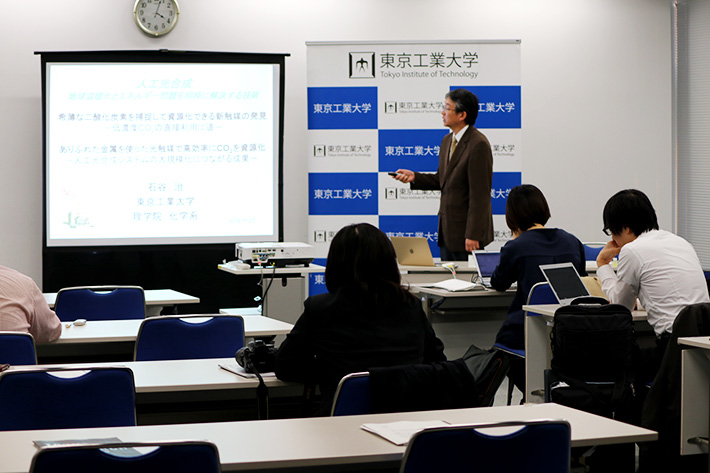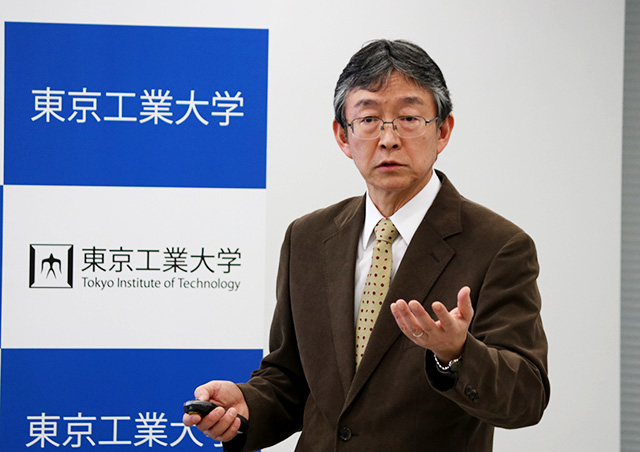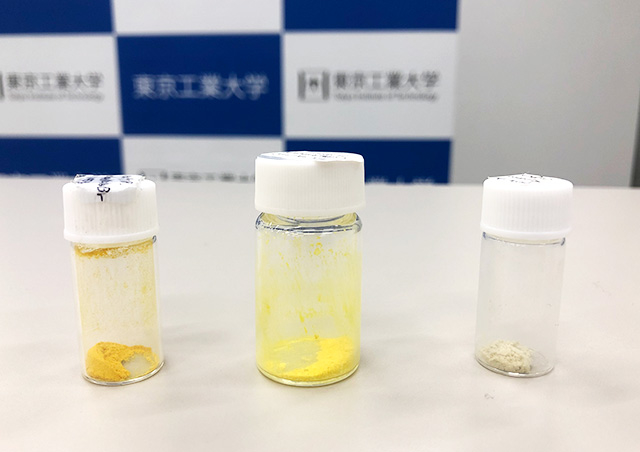
Professor Osamu Ishitani of the Department of Chemistry, School of Science held a press seminar to explain the discovery of new catalysts that convert carbon dioxide into a resource at Tokyo Tech's Ookayama Campus on November 27.
Industrial activities result in large amounts of CO2 emitted into the atmosphere. We do not possess practical technology to reduce and immobilize CO2 like plants do with photosynthesis. This is the root cause of three problems: the energy problem, carbon resource depletion, and global warming. If we achieved a practical technology to reuse emitted CO2 as a resource through artificial photosynthesis, we could anticipate a joint solution to these three problems.
Ishitani recently published papers on two breakthroughs regarding this problem and explained his findings at this press seminar.

Ishitani presenting findings
New catalyst captures low-concentration CO2 and converts it into a resource

Ishitani speaking to press
Conventional research on electrocatalytic reduction of CO2 had been conducted using pure CO2, since CO2 reduction does not process well at low concentrations. However, CO2 emissions from industrial sites such as thermal power stations are of low concentrations — around 10 percent. This means the energy-hungry process of concentrating CO2 is required before converting it into a resource.
The rhenium complex catalyst discovered by Ishitani and others can efficiently capture and reduce CO2 at low concentrations, even at levels of 1 percent. Application of this technology is anticipated to convert CO2 into a resource directly, eliminating the need to concentrate it.
Highly efficient CO2 resource conversion with photocatalyst of common-metal complexes

Developed catalyst
Ishitani and others have actively researched the photoreduction of CO2 and have succeeded in developing the world's most efficient photocatalyst in the past. However, this required the use of rare metals or expensive precious metals. CO2 emissions around the world reach 33 billion tons annually, and rare metals are no match for this volume. A photocatalyst using low-cost, high-volume metals was needed.
Ishitani and others have now shown that a photocatalyst of a copper-complex redox photosensitizer and a manganese-based catalyst can convert CO2 into a resource at an efficiency on par with photocatalysts using minor metals.
These two research findings could be the lead to solving the three problems of energy, carbon resource depletion, and global warming. An enthusiastic discussion between the press and Ishitani continued after the presentation.
Comments from Professor Ishitani
Photosynthesis uses sunlight to converts CO2 into a useful organic resource, portions of which convert into a fossil energy source after being stored underground over many years. We humans not only consume vast amounts of this energy source and chemical raw materials by digging it up, but also generate large amounts of CO2 by burning it. This is causing our planet to heat up and depleting a valuable energy source and carbon resources. These issues can be solved together if we gain the ability to use sunlight to reconvert large amounts of CO2 into a resource. I strongly believe that research on artificial photosynthesis can create significant impact both socially and scientifically, and I will continue to pour my efforts, though limited, into accomplishing this in cooperation with students and staff.
- *
- This article has been updated to correct the title on January 15.
. Any information published on this site will be valid in relation to Science Tokyo.







